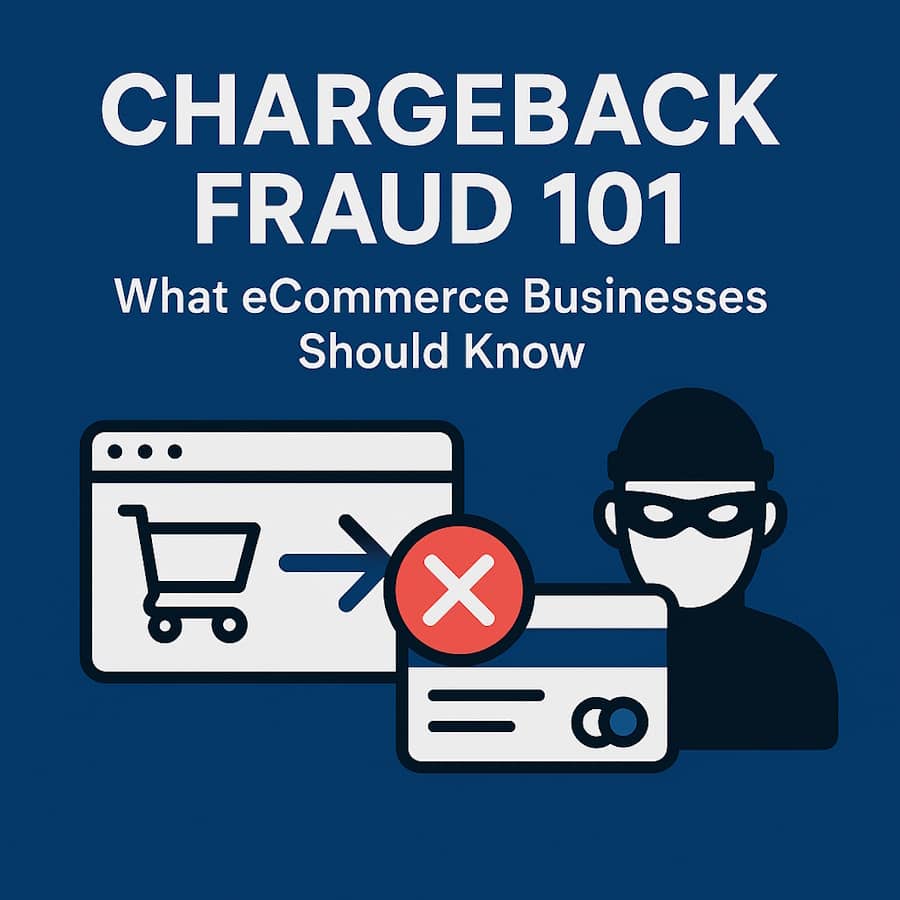An order ships out perfectly. The customer receives exactly what they ordered. Two weeks later, a chargeback notification appears claiming they never authorized the purchase. The product is gone, the payment reversed, and the fees pile up. This is chargeback fraud, and it happens thousands of times every single day to businesses just like yours.
First-party fraud now represents the leading fraud type globally, accounting for a third of all reported fraud in 2024, up from just 15% in 2023, representing a $132 billion risk to eCommerce, according to LexisNexis. Understanding this growing threat is no longer optional for online merchants who want to protect their revenue and stay in business.
What is Chargeback Fraud?
Chargeback fraud, also known as friendly fraud or first-party fraud, occurs when a customer makes a legitimate purchase but then disputes the charge with their bank to get a refund while keeping the product or service. Unlike traditional fraud, where stolen credit cards are used, chargeback fraud involves the actual cardholder abusing the dispute system designed to protect consumers.
The transaction looks legitimate in every way. The customer used their own card, provided their real information, and received what they ordered. But instead of requesting a refund through normal channels, they contact their bank, claiming the purchase was unauthorized, the product never arrived, or they were charged incorrectly.
What makes this particularly damaging is that the chargeback system inherently favors consumers. Banks prioritize cardholders, making it extremely difficult for merchants to win disputes even when they have clear evidence of a legitimate transaction.
The good news is that merchants can take proactive steps to reduce chargeback fraud. While eliminating it entirely is impossible, implementing the right combination of prevention strategies, clear policies, and customer-focused practices can significantly decrease fraudulent disputes and protect revenue. Understanding the different types of chargeback fraud is the first step toward building an effective defense.
The Different Faces of Ecommerce Chargeback Fraud
Understanding the motivations behind chargeback fraud helps merchants recognize patterns and implement better prevention strategies. These fraudulent disputes typically fall into several categories:
Buyer's Remorse: The customer regrets a purchase after receiving it. Rather than following the return policy, they dispute the charge as the faster, easier option. This accounts for a significant portion of friendly fraud cases.
Deliberate Theft: Some customers intentionally exploit the system to get free merchandise. They receive the product, enjoy using it, and then claim it never arrived or was unauthorized.
Family Fraud: A family member makes a purchase using a shared card, and the primary cardholder disputes it without realizing someone in their household made the transaction.
Confusion or Memory Lapse: Customers genuinely forget making a purchase, especially for subscriptions or digital services. When they see an unfamiliar charge, they automatically dispute it.
Delivery Disputes: The customer claims the product never arrived when it actually did. With the rise of package theft, this has become an increasingly common claim.
Why Chargeback Fraud Keeps Growing
Several factors have combined to create the perfect storm for rising fraud levels. Mobile banking apps make disputing transactions effortless, taking just a few taps on a smartphone. Many customers genuinely believe chargebacks are equivalent to refunds and don't understand the harm they cause to merchants.
Social media has also played a troubling role. Platforms like TikTok have popularized sharing tips about disputing legitimate transactions, normalizing what is essentially theft and encouraging younger consumers to view it as a harmless hack.
The numbers tell a stark story. Friendly fraud accounts for over 70% of all chargebacks, and the problem has accelerated dramatically in recent years. Major payment networks report that chargebacks increased substantially, with some industries seeing triple-digit percentage spikes.
Adding to the challenge, merchants win only about 8.1% of the disputes they represent, according to payment network data. This dismal success rate means fighting chargebacks often feels futile, encouraging more abuse as customers realize there are rarely consequences for filing fraudulent disputes.
Industry-Specific Vulnerabilities
Some business models face greater exposure to chargeback fraud than others. Understanding your specific risk factors helps prioritize prevention efforts.
| Industry Category | Primary Fraud Risk | Typical Chargeback Rate |
| Digital Goods & Services | Non-delivery claims | 0.6% - 1.2% |
| Subscription Businesses | Forgotten recurring charges | 0.5% - 1.0% |
| Fashion & Apparel | Buyer's remorse | 0.4% - 0.9% |
| Electronics & High-Value Items | Deliberate fraud | 0.7% - 1.3% |
| Travel & Hospitality | Cancellation disputes | 0.8% - 1.5% |
Digital goods and subscription services face particular challenges since there's no physical product to prove delivery. Electronics attract fraudsters due to high resale values. Travel and hospitality deal with cancellations and changing plans that customers try to reverse through chargebacks.
How to Reduce Chargeback Fraud
Fighting back against chargeback fraud requires a comprehensive approach that addresses multiple vulnerabilities. The following strategies work together to create layers of protection that make fraud harder to commit and easier to prove.
Make Your Business Recognizable
Many chargebacks start with confusion. Customers see an unfamiliar name on their statement and automatically dispute the charge. Use a billing descriptor that clearly matches your business name. Include your phone number in the descriptor so confused customers can call you instead of their bank.
Send detailed email confirmations immediately after purchase with recognizable sender information. Make these emails searchable so customers can easily find them when reviewing their statements.
Build Ironclad Documentation
Evidence wins the few disputes merchants actually win. Document everything about each transaction. Capture and store IP addresses, device fingerprints, delivery confirmations, customer communications, and any verification steps completed during checkout.
For digital products, log download times, IP addresses, and usage data. For physical goods, require signatures on high-value shipments. Keep this evidence organized and easily retrievable because chargeback windows are tight.
Implement Smart Fraud Detection
Modern fraud tools use machine learning to analyze hundreds of variables and flag suspicious patterns. These systems consider factors like:
- Geographic mismatches between billing and shipping addresses
- Unusual ordering patterns or velocities
- Device and browser characteristics
- Email and phone number validation
- Past fraud indicators
While these tools cost money, they pay for themselves by catching fraud before it processes. Even basic address verification services and CVV checks provide valuable protection layers.
Perfect Your Customer Experience
Exceptional service prevents chargebacks by keeping customers happy and building loyalty. Respond to inquiries quickly, ideally within hours. Make refunds and returns easy so customers don't need to resort to chargebacks.
Send proactive communications about shipping delays, delivery confirmations, and upcoming subscription renewals. When customers feel informed and valued, they're far less likely to dispute charges.
Leverage Chargeback Alerts
Alert services notify merchants when disputes get filed, often before they become official chargebacks. This narrow window allows issuing immediate refunds to stop the chargeback process, avoiding fees and preventing ratio increases.
While these services charge per alert, the cost typically runs less than chargeback fees plus the lost merchandise value. For businesses with moderate fraud levels, alerts provide excellent return on investment.
Advanced Defense Strategies
Once basic protections are in place, consider these advanced tactics to further reduce chargeback fraud:
Dynamic Descriptors: For businesses with multiple brands or product lines, use descriptors that include specific purchase details. Instead of just showing the company name, include the product category or specific item purchased to improve recognition.
Enhanced Verification: For high-value transactions or orders that trigger fraud warnings, add extra verification steps. This might include calling the customer, requiring photo ID, or using two-factor authentication.
Subscription Management Tools: Make canceling subscriptions easy and transparent. Send reminders before billing. Provide self-service cancellation options. Making the process smooth reduces forgotten-charge disputes.
Real-Time Monitoring: Watch for suspicious patterns like multiple failed payment attempts, rapid-fire orders, or mismatched data. Address red flags immediately rather than processing risky transactions.
Fighting Back When Fraud Happens
Despite best efforts, some chargeback fraud will slip through. When it does, knowing how to respond makes the difference between recovering revenue and losing everything.
Respond to every chargeback, even when the chances of winning seem slim. Gather all relevant documentation quickly since deadlines are strict. Write clear, professional rebuttal letters that present facts without emotion.
Focus on what payment processors want to see: proof of delivery, proof that the cardholder authorized the purchase, evidence that the customer received what they ordered, and documentation showing the customer knew what they were buying.
Track your win rates and analyze patterns in lost disputes. This reveals weaknesses in your evidence collection or areas where fraud tools need adjustment.
The Psychological Element
Understanding customer psychology helps reduce chargeback fraud. Many people don't realize that disputing legitimate transactions is actually theft. They view it as sticking it to big corporations or gaming the system, not understanding that it hurts small businesses.
Clear, human communication can prevent disputes. When customers feel they're dealing with real people who care about their experience, they're more likely to reach out directly with problems rather than immediately disputing charges.
Taking Action Today
Start by auditing your current chargeback situation. Calculate your actual ratio, identify which products or customer segments generate the most disputes, and pinpoint common dispute reasons.
Implement quick wins first. Fix unclear billing descriptors today. Set up basic fraud screening tomorrow. Add chargeback alerts next week. Layer on more sophisticated tools as your prevention program matures.
The goal is not eliminating all chargebacks, which is impossible. The goal is reducing fraud to manageable levels that don't threaten your business viability while maintaining a positive customer experience.
Chargeback fraud represents one of the biggest threats facing online merchants today. The abuse is growing, the costs are mounting, and the system favors fraudsters. But merchants who understand the problem and implement comprehensive prevention strategies can significantly reduce chargeback fraud and protect their hard-earned revenue. Taking action now, before fraud spirals out of control, makes the difference between surviving and thriving in the eCommerce landscape.








